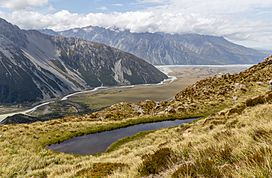Southland montane grasslands facts for kids
Quick facts for kids Southland montane grasslands |
|
|---|---|

Sealy Tarns in Aoraki / Mount Cook National Park
|
|

Ecoregion territory (in purple)
|
|
| Ecology | |
| Realm | Australasian |
| Biome | montane grasslands and shrublands |
| Borders | |
| Geography | |
| Area | 40,006 km2 (15,446 sq mi) |
| Country | New Zealand |
| Regions | Canterbury, Marlborough, Otago, Southland, Tasman and West Coast |
| Conservation | |
| Conservation status | Relatively stable/intact |
| Protected | 2,035 km² (5%) |
The Southland montane grasslands is a special natural area on New Zealand’s South Island. It is also called the South Island montane grasslands. This area is an ecoregion, which means it's a large region with its own unique plants and animals.
This ecoregion covers the middle part of the Southern Alps mountain range. Here you will find huge alpine grasslands, rocky areas called fellfields, and mountain forests.
Contents
Geography of the Southern Alps
The Southern Alps are a very long mountain range. They stretch for about 500 kilometers (310 miles) across the South Island. They run from the northeast to the southwest.
Aoraki/Mount Cook is New Zealand's highest mountain. It stands at 3,754 meters (12,316 feet) tall and is located in the Southern Alps.
The weather changes a lot across these mountains. The western side gets a lot of rain. But the eastern side is usually much drier.
Plants of the Mountains
The main type of plant life here is alpine grassland. This is also known as tussock herbfield. These grasslands grow above the treeline, which is the height where trees stop growing. This is usually around 1,200 meters (3,900 feet) high.
Tussock Grasses
Tussock grasses are very common here. Most of them belong to the Chionochloa family. These grasses live for a long time and grow slowly.
- The broadleaved snow tussock (Chionochloa flavescens) and Chionochloa pallens grow well in young or well-drained soils.
- C. rigida is found more on the drier eastern side of the mountains.
- At higher altitudes, you will see the smaller curled snow tussock (C. crassiuscula).
Other plants grow among the tussock grasses. These include speargrasses (Aciphylla species) and sedges (Carex species). You can also find Ranunculus buttercups. One special one is Ranunculus lyallii, which is the biggest buttercup in the world!
Mountain Forests
Below the treeline, you will find mountain forests. These forests are made up of southern beech trees (Nothofagus).
- Mountain beech (Nothofagus solandri cliffortoides) often grows on steep hillsides.
- Evergreen silver beech (Nothofagus menziesii) and red beech (N. fusca) are common in valleys and on lower hillsides.
On the western side of the mountains, there are mixed forests. These include silver beech and podocarp trees. You can also find podocarp and southern rata (Metrosideros umbellata) forests.
The change from the beech forests to the alpine grasslands is usually sudden. But on the western side, there is a thick area of woody shrubs. These include Dracophyllum traversii. This area creates a more gradual change between the forests and the grasslands. Other shrubs like snow tōtara (Podocarpus nivalis), Hebe species, and Coprosma species grow near the treeline.
Animals of the Mountains
This ecoregion is home to several birds that are unique to New Zealand. This means they are found nowhere else in the world!
- The New Zealand rock wren (Xenicus gilviventris)
- The kea (Nestor notabalis), a very smart parrot
- The great spotted kiwi (Apteryx haastii)
- A southern type of New Zealand kaka (Nestor meridionalis meridionalis)
Protected Areas
Many parts of the Southland montane grasslands are protected. This helps keep the plants and animals safe. In 2017, it was found that about 12,035 square kilometers (4,647 square miles) of this ecoregion are protected. This is about 5% of the total area.
Some of the protected areas include:
- Eyre Mountains/Taka Ra Haka Conservation Park
- Mavora Lakes Stewardship Area
- Mount Aspiring National Park
- Nelson Lakes National Park
- Westland Tai Poutini National Park
- Arthur's Pass National Park
- Aoraki / Mount Cook National Park
- Craigieburn Forest Conservation Park
- Adams Wilderness Area

